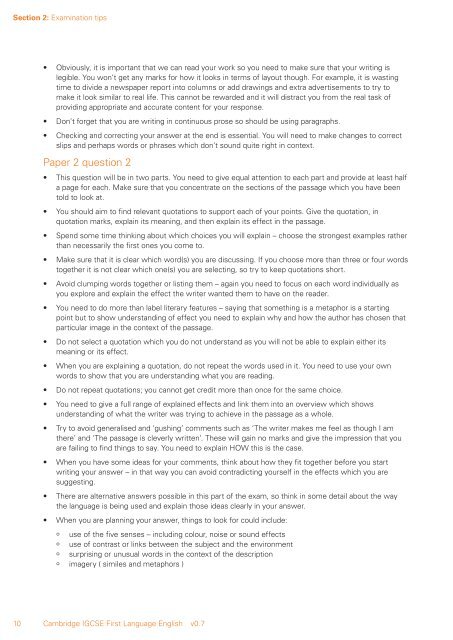163028-cambridge-learner-guide-for-igcse-first-language-english
163028-cambridge-learner-guide-for-igcse-first-language-english
163028-cambridge-learner-guide-for-igcse-first-language-english
- No tags were found...
Create successful ePaper yourself
Turn your PDF publications into a flip-book with our unique Google optimized e-Paper software.
Section 2: Examination tips<br />
• Obviously, it is important that we can read your work so you need to make sure that your writing is<br />
legible. You won’t get any marks <strong>for</strong> how it looks in terms of layout though. For example, it is wasting<br />
time to divide a newspaper report into columns or add drawings and extra advertisements to try to<br />
make it look similar to real life. This cannot be rewarded and it will distract you from the real task of<br />
providing appropriate and accurate content <strong>for</strong> your response.<br />
• Don’t <strong>for</strong>get that you are writing in continuous prose so should be using paragraphs.<br />
• Checking and correcting your answer at the end is essential. You will need to make changes to correct<br />
slips and perhaps words or phrases which don’t sound quite right in context.<br />
Paper 2 question 2<br />
• This question will be in two parts. You need to give equal attention to each part and provide at least half<br />
a page <strong>for</strong> each. Make sure that you concentrate on the sections of the passage which you have been<br />
told to look at.<br />
• You should aim to find relevant quotations to support each of your points. Give the quotation, in<br />
quotation marks, explain its meaning, and then explain its effect in the passage.<br />
• Spend some time thinking about which choices you will explain – choose the strongest examples rather<br />
than necessarily the <strong>first</strong> ones you come to.<br />
• Make sure that it is clear which word(s) you are discussing. If you choose more than three or four words<br />
together it is not clear which one(s) you are selecting, so try to keep quotations short.<br />
• Avoid clumping words together or listing them – again you need to focus on each word individually as<br />
you explore and explain the effect the writer wanted them to have on the reader.<br />
• You need to do more than label literary features – saying that something is a metaphor is a starting<br />
point but to show understanding of effect you need to explain why and how the author has chosen that<br />
particular image in the context of the passage.<br />
• Do not select a quotation which you do not understand as you will not be able to explain either its<br />
meaning or its effect.<br />
• When you are explaining a quotation, do not repeat the words used in it. You need to use your own<br />
words to show that you are understanding what you are reading.<br />
• Do not repeat quotations; you cannot get credit more than once <strong>for</strong> the same choice.<br />
• You need to give a full range of explained effects and link them into an overview which shows<br />
understanding of what the writer was trying to achieve in the passage as a whole.<br />
• Try to avoid generalised and ‘gushing’ comments such as ‘The writer makes me feel as though I am<br />
there’ and ‘The passage is cleverly written’. These will gain no marks and give the impression that you<br />
are failing to find things to say. You need to explain HOW this is the case.<br />
• When you have some ideas <strong>for</strong> your comments, think about how they fit together be<strong>for</strong>e you start<br />
writing your answer – in that way you can avoid contradicting yourself in the effects which you are<br />
suggesting.<br />
• There are alternative answers possible in this part of the exam, so think in some detail about the way<br />
the <strong>language</strong> is being used and explain those ideas clearly in your answer.<br />
• When you are planning your answer, things to look <strong>for</strong> could include:<br />
° use of the five senses – including colour, noise or sound effects<br />
° use of contrast or links between the subject and the environment<br />
° surprising or unusual words in the context of the description<br />
° imagery ( similes and metaphors )<br />
10 Cambridge IGCSE First Language English v0.7


